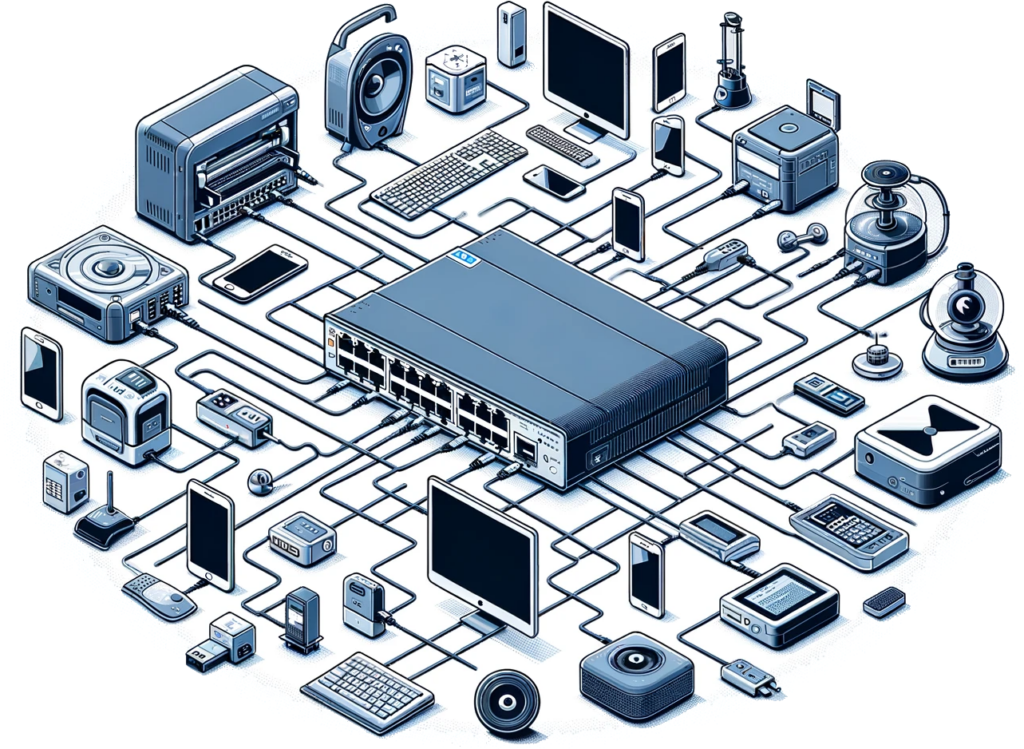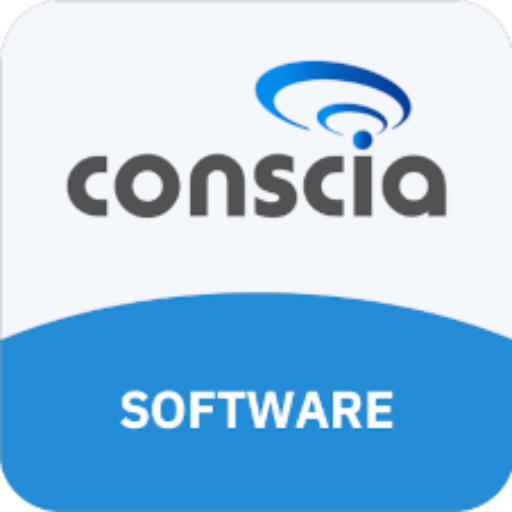
This white paper explores the challenges and potential solutions for managing devices on network infrastructures with no centralized management system. Whether you’re an IT decision-maker or a network architect working with wired or wireless enterprise access networks, this paper will help you build a shared understanding of the topic and provide insights into effective strategies for managing decentralized network environments.
In the today’s enterprise infrastructure, secure and easy networks access is crucial. Designing a secure enterprise network is achievable, yet complexities arise when incorporating unmanaged devices. These include printers, cameras, meeting room technologies, 3D printers, sound systems, medical devices, and PLCs (Programmable Logic Controllers). This article delves into the challenges of onboarding these devices. It moves beyond traditional methods, such as static VLAN assignments and special case Pre-Shared Key (PSK) SSIDs. Instead, we focus on alternativ, more secure, and less time-consuming solutions.
The Onboarding Challenge in Enterprise Networks
Onboarding hosts into an enterprise access network is more than just connectivity. It requires integrating every host, from mobile phones to office printers, into the network in a way that is both secure and supportive of business objectives. While traditional methods like static VLAN assignments and the use of special case Pre-Shared Key (PSK) SSIDs were once popular, they are increasingly viewed as insufficient to meet the complex demands of modern network environments.
Static VLAN Assignments
Assigning static VLANs to switch ports, such as for a printer, is a common practice in traditional network design but comes with several challenges. Initially, it requires manual configuration, leading to each switch having a unique setup. This uniqueness necessitates additional effort when replacing switches. Moreover, if a cable is mistakenly connected to the incorrect port, it can disrupt connectivity, potentially compromising both compliance and functionality. This method can be labor-intensive and prone to human error, affecting the overall network efficiency and security.
Special Case PSK SSIDs
This method used different SSIDs for various device types or user groups, each with its own PSK. While it simplifies device management to some degree, it doesn’t efficiently scale and introduces significant security risks. Shared PSKs can become compromised with the risk of unautorized access to the network or man-in-the-middel attack on connected devices. Further more deploying to many SSID is can cause roaming and associations issues as wall as general performance degredation.
Manual dot 1x setup
While some unmanaged devices may support dot1x configuration, setting up a PEAP profile with a service account, for instance, introduces scalability challenges. Changes to the RADIUS server or certificate infrastructure could necessitate updates to all connected devices. Given this, implementing dot1x configurations on devices lacking a central management platform is generally not advisable. The potential for widespread, labor-intensive updates poses significant operational challenges, making this approach less feasible for large-scale enterprise environments
In the upcoming sections, we’ll delve into how modern solutions like MAC Authentication Bypass (MAB) for LAN and Identity PSK (iPSK) for Wi-Fi can effectively address these challenges. Additionally, we will discuss the need of a registration process and the advantages of implementing a self-service device onboarding system. We’ll also highlight how the Conscia Device Portal can help implement MAB and iPSK in your network management.
Understanding Managed vs. Unmanaged Devices
Managed Devices
In the context of an enterprise network, managed devices typically include company-issued computers, laptops, and mobile phones. These devices are controlled and monitored by the organization’s IT department. They come with pre-installed security measures and are regularly updated and maintained. Managed devices are easier to onboard onto the network due to their uniformity and the ability to enforce corporate policies.
Unmanaged Devices
Unmanaged devices present a different challenge. These include a variety of equipment like printers, surveillance cameras, smart meeting room systems, 3D printers, audio systems like Sonos, medical devices, and PLCs. These devices are often not directly managed by the organization’s IT team and may lack standard security features. Their diversity in operating systems, firmware, and connectivity options makes the onboarding process more complex.
The mix of managed and unmanaged devices creates a challenge. While managed devices can be onboarded with relative ease due to standardized security and connectivity protocols, unmanaged devices require a more nuanced approach. They often need specific configurations and may not align seamlessly with the existing network security policies.
Alternativ Onboarding Solutions
In response to the challenges posed by a mix of managed and unmanaged devices, alternative onboarding solutions like MAC Authentication Bypass (MAB) for LAN and Identity Pre-Shared Key (iPSK) for Wi-Fi have been developed.
MAB for LAN
MAB is an alternative to 802.1X, used for devices that do not support this protocol. In MAB, the device is authenticated based on its MAC address. When a device connects to the network, its MAC address is checked against a database of approved devices. If the MAC address is recognized, the device is granted access. This method simplifies the onboarding of unmanaged devices which might not have the capability to participate in a more complex authentication process.
iPSK for Wi-Fi
Identity Pre-Shared Key offers a unique PSK for each user or device. Unlike traditional PSK that uses the same key for all devices on a network, iPSK assigns a unique key to each device, improving security. iPSK allows for easier management and more secure onboarding of devices, especially unmanaged ones, as each device has a distinct identity and key.
Both MAB and iPSK provide more flexibility and security than traditional onboarding methods. They are particularly effective for onboarding a wide range of devices with varying levels of management and security capabilities. These methods also facilitate better control over network access, ensuring that only authorized devices can connect to and operate within the enterprise network.
In the next sections, we will explore the importance of the device registration process and discuss the implementation of self-service device onboarding, highlighting the role of the Conscia Device Portal in streamlining these processes.
The Registration Process and Network Management
A key component of successfully implementing MAB for LAN and iPSK for Wi-Fi is the registration process of devices. This process is pivotal in ensuring that only authorized devices are granted access to the network.
Device Registration
This involves cataloging each device with its unique identifiers, such as MAC addresses for MAB and distinct PSKs for iPSK. The registration process is crucial for maintaining a secure network environment, especially when dealing with a large number of unmanaged devices. It allows the network administrators to keep track of which devices are connected to the network, manage access permissions, and quickly identify and mitigate any unauthorized access attempts.
Best Practices for Network Management
With the alternative onboarding solutions like MAB and iPSK, network management becomes more streamlined yet requires vigilance. Regular audits of the device registry, updating the security protocols, and monitoring network traffic are essential practices. Additionally, implementing a tiered access level system, where devices have access only to the necessary network resources, can significantly enhance network security.
The efficient management of this process not only enhances security but also ensures that the network can handle the diverse range of device types and functionalities without compromising performance.
Implementing Self-Service Device Onboarding
Self-service device onboarding streamlines the process of integrating new devices into the network, reducing the workload on IT staff and increasing overall efficiency.
Benefits of Self-Service Onboarding:
- Empowering Users: Allows users to register and onboard their devices autonomously, leading to faster integration and less administrative burden on the IT team.
- Efficiency and Scalability: Streamlines the onboarding process, especially beneficial in environments with a high volume of devices or frequent device changes.
- Enhanced Security: Despite the autonomous nature, self-service portals can be configured to maintain stringent security standards, ensuring that only compliant and authorized devices are onboarded.
Implementing a self-service device onboarding system involves creating a user-friendly portal where users can register their devices. This portal can be integrated with the organization’s security protocols to ensure compliance and can be customized to suit specific organizational needs.
Conscia Device Portal – Your Onboarding Solution
The Conscia Device Portal is an effective solution for establishing a self-service device onboarding system. It simplifies the process of registering and managing both managed and unmanaged devices on enterprise LANs and Wi-Fi networks.
Features of Conscia Device Portal:
- Self-Service portal enables IT to delegate the task of onboarding devices to the device owners. Based on users AD group users will be able to administer there valid devices and permissions.
- Implement MAC Authentication Bypass as a supplement to dot1x on your network to get full authentication on all port using.
- Get segmentation and improved security on one single shared PSK network using iPSK for boarding wireless devices.
- Strong audit-trail for unmanaged devices using the audit-log and reference to device ownership.
By leveraging the Conscia Device Portal, organizations can efficiently manage the onboarding devices, ensuring network security and performance.
Conclusion
Building a secure and usable enterprise LAN and Wi-Fi network requires a balance between security, efficiency, and practicality. As we’ve explored, there are challenges when dealing with a mix of managed and unmanaged devices, ranging from essential office equipment to specialized devices like medical instruments and PLCs. Traditional methods like static VLAN assignments and special case PSK SSIDs are no longer sufficient in addressing the needs of modern, dynamic enterprise environments.
The introduction of alternative onboarding solutions like MAC Authentication Bypass (MAB) for LAN and Identity Pre-Shared Key (iPSK) for Wi-Fi represents a significant advancement in network management. These methods provide the flexibility and security necessary to manage the diverse range of devices encountered in today’s enterprises. However, the effectiveness of these solutions requires a robust registration process, where devices are accurately entered and monitored.
Implementing a self-service device onboarding system, such as the Conscia Device Portal, solves this. It enables users to autonomously onboard their devices while ensuring that all security policy are followed.
In conclusion, as enterprises continue to grow and evolve, the need for efficient and secure device onboarding solutions becomes increasingly critical. The Conscia Device Portal offers a streamlined, user-centric approach to managing this process, ensuring that network integrity and performance are maintained.
